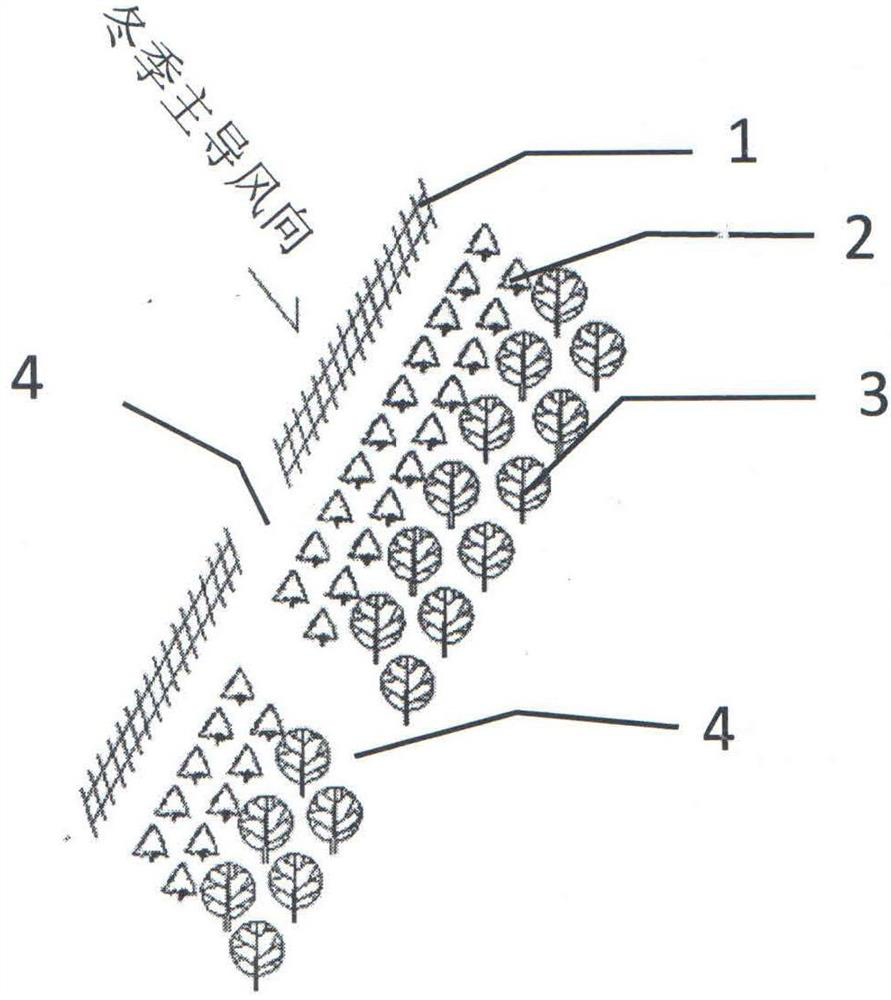A method of ecological utilization of wind and snow flow in Mongolian plateau grassland
A snowstorm, ecological technology, applied in the fields of land preparation methods, applications, agricultural machinery and implements, etc.
- Summary
- Abstract
- Description
- Claims
- Application Information
AI Technical Summary
Problems solved by technology
Method used
Image
Examples
Embodiment 1
[0015] a. Choose a location with open and flat terrain;
[0016] b. Along the direction perpendicular to the local prevailing wind direction in winter, three mechanical wind barriers 1 with a height of 1.2m are arranged in parallel, and the ventilation structure is adopted, the ventilation coefficient is kept at 60%, and the width interval of each mechanical wind barrier 1 is 50m;
[0017] c. Plant 4 rows of native shrub seedlings on the leeward side of each mechanical wind barrier 1 at a position twice the height of the wind barrier, and establish a plant wind barrier 2. The spacing between seedlings and rows in the plant wind barrier 2 is 2m, and the seedlings between the rows are staggered in the shape of a character. Layout, the planting row close to the mechanical wind barrier 1 selects the shrub plant species with a smaller plant type as Caragana 5, and the planting row far away from the mechanical wind barrier 1 selects the taller shrub plant species as Caragana 3;
[0...
Embodiment 2
[0020] a. Choose a site with slightly low-lying terrain.
[0021] b. Arrange five mechanical wind barriers 1 in parallel along the direction that intersects with the local dominant wind direction in winter at a large angle > 60°. Mechanical wind barriers 1 can use various sand barriers for reference. The height is 1.5m, and the ventilation structure is adopted to maintain a ventilation coefficient of 70%. , each mechanical wind barrier 1 has a width spacing of 70m;
[0022] c. At 8 times the height of the wind barrier on the downwind side of each mechanical wind barrier 1, plant 6 rows of native shrub seedlings to establish a plant wind barrier 2. The spacing between the seedlings in the plant wind barrier 2 and the row spacing are 3m, and the seedlings between the rows are staggered in the shape of a character Layout, the planting row close to the mechanical wind barrier 1 selects the shrub plant species Caragana 2 with a relatively short plant type, and the planting row far ...
Embodiment 3
[0025] a. Choose a slightly low-lying area;
[0026] b. Along the direction perpendicular to the local prevailing wind direction in winter, 6 mechanical wind barriers 1 with a height of 1.8m are arranged in parallel, adopt a ventilation structure, the ventilation coefficient is kept at 80%, and the width of each mechanical wind barrier 1 is 100m apart;
[0027] c. At 10 times the height of the wind barrier on the downwind side of each mechanical wind barrier 1, plant 8 rows of native shrub seedlings, and establish a plant wind barrier 2. The plant and row spacing of the plant wind barrier 2 is 3m, and the seedlings between the rows are staggered in the shape of a character. Layout, the planting row close to the mechanical wind barrier 1 selects the shrub plant species Caragana 5 with a relatively short plant type, and the planting row far away from the mechanical wind barrier 1 selects the shrub species Haloxylon 3 with a relatively large plant type;
[0028] d. Make the mecha...
PUM
 Login to View More
Login to View More Abstract
Description
Claims
Application Information
 Login to View More
Login to View More - R&D
- Intellectual Property
- Life Sciences
- Materials
- Tech Scout
- Unparalleled Data Quality
- Higher Quality Content
- 60% Fewer Hallucinations
Browse by: Latest US Patents, China's latest patents, Technical Efficacy Thesaurus, Application Domain, Technology Topic, Popular Technical Reports.
© 2025 PatSnap. All rights reserved.Legal|Privacy policy|Modern Slavery Act Transparency Statement|Sitemap|About US| Contact US: help@patsnap.com

